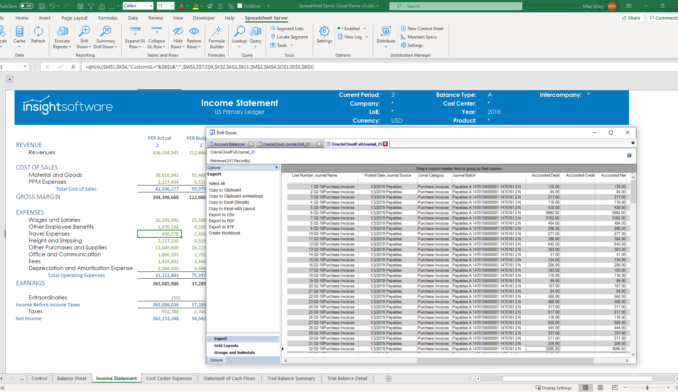Digging for Gold: How to Unearth Hidden Working Capital Issues with Real-Time Reporting Tools

Some of the most innovative businesses in the world fail before they ever get off the ground. The problem? Inadequate working capital.
In 1999, S.L. Mintz wrote:
“As levers of financial management go, none bears more weight than working capital. The viability of every business activity rests on daily changes in receivables, inventory, and payables.”
That point is more familiar to most people in an abbreviated form: “cash is king”. While that version may be less nuanced than Mintz’s statement, it ultimately arrives at the same conclusion. Businesses that efficiently manage and deploy capital resources will be better positioned to address the fundamental requirements of meeting payroll, shipping product, and paying vendors. Moreover, companies that do well in the basics of managing working capital will generally outperform those that do poorly.
- Read: Best CFO KPIs and Dashboards for the 2021 CFO
- Download: Economic Downturn KPI Sample Dashboard
- Read: How to Build a Free Cash Flow Dashboard, with Downloadable Template
Where is working capital tied up? The usual suspects are accounts receivable and inventory, although any underperforming asset or expense category should be a candidate for review and potential elimination.
For many small and mid-sized businesses, the efficiency of working capital is the key factor in determining whether or not management can keep the lights on and make payroll. For some, insufficient cash flow is an almost constant source of concern. It’s ironic that many of those same businesses fail to devote the necessary time and energy to optimizing working capital. It’s one of those things that is always important, but rarely urgent… except when it is.
When a cash crunch hits, the business managers who have optimized working capital will be better positioned to survive the crisis without resorting to costly financing, liquidating assets at the wrong time, or other desperate measures.
When opportunities emerge, the companies that have deployed capital efficiently will be better positioned to take advantage of them. Whether it’s the opportunity to buy out a competitor, or the need to scale up production quickly to serve a potential large new customer, businesses with a lean balance sheet will be better positioned to finance those opportunities.
Finally, organizations that focus on working capital efficiency simply outperform those that do not. The Rockefeller Principles, touted by innovative business leaders as the bedrock values of high-growth enterprises, place a strong emphasis on cash, listing it as one of the four pillars of good management. According to SunTrust, “top performers manage working capital up to 4 times more efficiently than industry laggards, and many companies are unaware of significant, untapped working capital improvement opportunities.”
Unfortunately, too many business managers overlook opportunities to improve working capital efficiency. As a result, 53 percent of businesses experience at least one gap in working capital each year.
So how does a growing business gain a better understanding of working capital efficiency and start down the road toward improvement? It starts with understanding the key levers of working capital, benchmarking your organization’s performance, and following the numbers closely.
Key Working Capital Metrics
For many finance teams, key performance indicators include metrics like days sales outstanding (DSO), which signifies the business’ capacity to turn revenue into cash. DSO focuses on the management of accounts receivable specifically, though. While that’s important, you should first step back and look at the bigger picture.
There are several KPIs that the executive team should be tracking that reflect the organization’s overall efficiency in managing working capital. Specifically, those include “cash conversion cycle” (CCC) and “days working capital” (DWC).
CCC and DWC provide a top-level assessment of the organization’s ability to deploy working capital efficiently.
CCC (“cash conversion cycle”) is calculated by adding days sales outstanding (DSO) to days inventory outstanding (DIO), then subtracting days payables outstanding (DPO). The lower the resulting number, the better.
DWC “days working capital” is calculated by dividing net operating assets (that is, current operating assets minus current operating liabilities) by annual sales, then multiplying the result by 365. Again, the lower the number, the better, as it indicates that the company is operating at high efficiency.
Interestingly, neither of those metrics will show up on a typical ERP system report. The library of off-the-shelf reports that are typically provided as part of an ERP system tends to be geared toward operational tasks and standard-format financial statements. While some of the subsequent measures discussed here might be available with a bit of digging, the majority of ERP systems do a far better job of recording, storing, and processing information than they do of displaying that information and helping managers to draw useful insights from it.
Business leaders who wish to maximize the value they can get out of an ERP system, on the other hand, tend to seek out third-party reporting tools that are purpose-built to drive incremental value from the data that their ERP and CRM systems store and manage.
Download our free Working Capital report template to easily visualize key working capital KPIs for your organization.
Now that we have looked at a few of the top level KPIs that indicate working capital efficiency, let’s drill down on some of the individual levers that business managers can apply for increased performance. They correlate directly to the three levers of the cash conversion cycle (CCC) equation: inventory, accounts receivable, and accounts payable.
The Three Levers of the Cash Conversion Cycle
Lever 1: Inventory
Many companies have a substantial portion of their money tied up in inventory. Reducing inventory on hand allows for more efficient production planning and operations, and it converts the value of product that is sitting on the shelf to cash in the bank.
Inventory reduction has other benefits as well. The cost of holding inventory is often overlooked. Companies that hold less inventory require less warehouse space and fewer personnel to manage it. Insurance and excise taxes may reduce as inventory levels decline.
Finally, there is the problem of inventory shrinkage. Pilferage occurs in almost any business. Spoilage or damage destroys value in some percentage of inventory on hand. You must often mark down or liquidate obsolete items, and the more inventory you have, the higher the risk of that happening.
A good ERP system can go a long way toward optimizing inventory management with accurate demand forecasting, effective control over quantities and locations, and improved processes for managing inventory. By minimizing quantities of slow-moving inventory, liquidating items that are at risk of losing significant value through obsolescence, and optimizing everything else, a company can continue to fill customer orders quickly without keeping excessive stock on hand.
Inventory optimization can quickly become complicated when you are distributing items across multiple warehouses and/or retail locations. If you are selling some items as distinct SKUs that also serve as sub-assemblies to other inventory items, or if minor product variations occur across regions or customer segments, complexity grows quickly.
It is nearly impossible to create a one-size-fits-all system for understanding and optimizing inventory. ERP systems do a very good job of providing the necessary levers and switches required to classify and manage inventory, but standard ERP reports that accompany those modules leave quite a lot to be desired.
Managers need clear answers to ad hoc questions about inventory obsolescence and liquidation, seasonal fluctuations, carrying costs, shrinkage, and more. The stock reports that come with most ERP systems can’t typically answer those kinds of questions. To maximize your organization’s capability for managing inventory and driver-based planning efficiently, powerful self-service reporting tools are essential.
Lever 2: Accounts Receivable
Managing accounts receivable efficiently results in faster payment, which in turn helps to shorten the cash conversion cycle. Businesses can free up significant amounts of cash by monitoring and aggressively managing DSO (“day sales outstanding”), without resorting to borrowing money or using accounts receivable as collateral.
In most companies, sales and finance have conflicting goals. Finance seeks to minimize DSO while the sales team seeks to maximize top-line revenue, which is often made easier by extending generous credit terms. Using a data-driven approach to balance these two competing objectives, savvy managers can continue to drive sales while optimizing cash. That requires access to a broad range of information, including order history and payment history from the ERP system, sales quotations from CRM, and potentially data from external sources.
Although most ERP systems do a great job of recording transactional information, they tend to fall short when it comes to extracting and formatting that information in a meaningful way, for example, when the credit manager wants to assess credit risk based on information from multiple systems in real time. This is where the right third-party reporting tools can add significant value.
Lever 3: Accounts Payable
Accounts payable often gets less attention than inventory or receivables in discussions about the cash conversion cycle. You should not overlook it as an important lever of control in the working capital equation. By analyzing purchasing patterns and negotiating more generous payment terms, companies can extend payables and increase financial leverage without incurring any additional financing costs.
Early-payment discounts provide a huge return on capital. A company that takes advantage of 2/10 net 30 terms (a two percent discount for paying within ten days, rather than the usual 30) is effectively earning a return of 36.7 percent merely by paying an invoice 3 weeks earlier than they otherwise would. By freeing up excess cash across all of the working capital levers, businesses can take advantage of such opportunities, provided that they pay close attention and make it part of their routine business processes.
When used in combination with a disciplined process for collections and aggressive inventory optimization, payables management can provide a substantial measure of additional value in the context of working capital efficiency.
Staying in Good Standing with Lenders
The three levers of working capital directly impact the amount of free cash available to an organization. This leads to one additional factor: remaining in good standing with lenders, which is the result of the first three. Banks and other lenders look closely at an organization’s balance sheet when determining creditworthiness, including lines of credit, loan amounts, and interest rates. If the time comes when the business needs a bridge loan or a cash infusion to finance growth, companies with high working capital efficiency will fare better than their lower-efficiency peers. As discussed earlier, there are a number of KPIs that reflect the organization’s overall efficiency in managing working capital. Those include “cash conversion cycle” (CCC), “days working capital” (DWC), “days sales outstanding” (DSO) for accounts receivable, “days payables outstanding” for A/P, and “days inventory outstanding” (DIO).
Off-the-shelf ERP system reports won’t typically include those metrics, so business leaders should develop systems for monitoring and measuring those KPIs to keep the organization’s attention focused on the key levers. PwC recommends a four-step process for improving working capital efficiency. Reporting and analytics plays an essential role in PwC’s process by helping companies drill down into problem areas, devise innovative solutions, and measure the results of corrective action.
Business leaders should also look for benchmark comparisons against which to measure their company’s own performance. SunTrust advises companies to seek benchmarking data from industry trade groups, CPAs and other professional advisors, and government sources. Those kinds of numbers provide a baseline against which to establish target performance and monitor outcomes.
Real-Time Visibility Across the Enterprise
To manage working capital at peak efficiency, it is first necessary to have a robust ERP system that can efficiently serve as a mechanism for recording and organizing transactional data, as well as providing a framework for the processes used to manage those transactions. Unfortunately, however, most ERP implementations fall far short of the potential value they could deliver, primarily because so much of the data they contain is unavailable to the people who could use it to improve business operations.
Every business is unique, and businesses change over the course of time. Although ERP software has evolved to accommodate a wide variety of different scenarios, the stock reports that come with most ERP systems still seem to be built around the one-size-fits-all philosophy.
The report writers that come with most ERP systems tend to be complicated, requiring specialized IT skills even for simple modifications. That creates unnecessary delays whenever someone in the business needs a quick answer to an important question.
For the people who work with ERP systems on a day-to-day basis, the ability to develop reports and queries without specialized IT training is a game changer. At insightsoftware, we provide financial intelligence tools for over 140 different ERP systems,. For nearly three decades, we have been helping business leaders get the information they need quickly, accurately, and efficiently. If your organization is aiming to increase your working capital efficiency in the coming year, contact us today to get a live demo.










